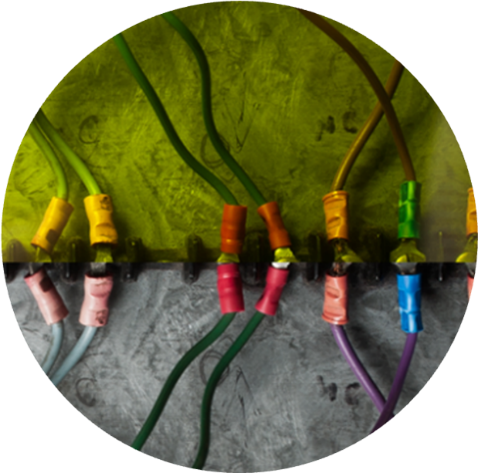Seeing Clearly: The Evolution of Arc Flash Faceshield Technology
In electrical work, protection and precision go hand in hand. Over the years, arc flash PPE has come a long way—from the early days of green-tinted shields that compromised visibility, to today’s innovative designs that offer true-to-color clarity without compromising protection.
This evolution hasn’t just made work more comfortable—it’s made it safer. In environments where identifying a wire’s color or reading a panel correctly can mean the difference between a job well done and a catastrophic mistake, clear vision is non-negotiable. This article explores the shortcomings of legacy faceshields and how technology & standards have advanced through the years with an emphasis on the importance of optical clarity.
How Legacy Faceshields Compromised Accuracy on the Job
Arc flash events generate an immense amount of infrared light. Historically, faceshields were tinted green to absorb this light and protect the workers in the unfortunate event of an arc flash. The greater the protection level, the darker the shield—and the more intense the green tint. PPE rated for CAT 4 exposures, for example, would block significant infrared light but also distort a broader range of colors.
This meant that as protection levels increased, color perception decreased. Yellow could appear white, green might look blue, and workers were forced to operate with a limited visual range—often in high-stakes environments.

Green-tinted shields served their purpose for many years. They were an important step forward—but came with clear trade-offs in visual performance. As the limitations of older green-tinted faceshields became more apparent—particularly in environments where accurate color recognition is critical—industry standards began to evolve in response. Regulators and safety organizations recognized that protection alone wasn’t enough; workers also needed to see clearly to stay safe.
What OSHA and ANSI Say About Visibility
While OSHA outlines when eye and face protection is required, ANSI Z87.1 helps to understand the most appropriate protection needed based on specific workplace hazards. Over the years, the ANSI Z87.1 standard has evolved to capture performance over a wide array of criteria such as impact protection, protection from radiation, and visible light transmission. Performance criteria must be tested and marked according to ANSI Z87. This evolution signals a growing recognition of how crucial visual clarity is—not just protection. Under the OSHA General Duty Clause, employers are required to select eye and face protection that’s appropriate for the task at hand, which includes ensuring workers can see clearly.
One critical measure of optical clarity is the Luminous Transmission Test, Visual Light Transmission (VLT). Rated on a scale from 1.3 to 10, the lower the rating, the better the VLT.
Simply put: When choosing arc flash PPE for your team, it’s not enough to check the arc rating. Faceshields with poor performance on the VLT can cause blurry vision, eye strain, and misinterpretation of detail. That doesn’t just slow productivity— it creates unsafe conditions. Workers might remove their faceshields to get a better look, or they might miss small visual indicators entirely. Fortunately, tremendous strides have been made in creating PPE that meets protection requirements without compromising optical clarity.
Nanoparticles: A Revolution in Arc Flash Faceshield Technology
Nanotechnology–the science and engineering of ultra-fine particles known as nanoparticles— has revolutionized faceshield performance. It’s the key to how Enespro’s modern faceshields deliver both outstanding protection AND optical clarity.
Through extensive R&D, scientists have discovered ways to manipulate the structure of materials at the nanoscale to achieve properties tailored to specific applications. Some examples of qualities that can be changed or enhanced include:
- Strength
- Weight
- Electrical Conductivity
- Chemical Reactivity
- Filtration Ability
Paulson Manufacturing – a subsidiary of NSA/Enespro – has pioneered the integration of nanoparticle technology into arc flash faceshields for electrical work. With this technology, the shields can absorb black-body radiation while still allowing high visible light transmission and full-spectrum color recognition.
Product Spotlight: Enespro Hover XTR Series Faceshield
The Enespro Hover XTR Series faceshields are the latest to feature Paulson’s nanoparticle technology. These advanced faceshields offer protection against Infrared Radiation (R10) and deliver excellent visible light transmission (L1.7), enabling full color spectrum recognition and true-to-color visibility. But the innovation does not stop with nanoparticle technology. The XTR design continues to push the boundaries of performance in arc flash faceshields by addressing another often-overlooked issue in visual clarity: lens shape.
Color is not the only issue when it comes to visual clarity, the shape of the faceshield lens can cause glare and visual distortion. Cylindrical lenses cause peripheral light to refract incorrectly before hitting the eye, creating glare—much like how individuals with astigmatism perceive light at night, often with flares or halos.
The XTR features an innovative toric lens design, inspired by modern optometry. Unlike cylindrical lenses, the toric shape follows the natural curvature of the human eye, allowing light to pass through the lens more accurately and consistently. The result is a sharper, clearer, and more comfortable viewing experience with reduced glare and distortion—especially important during tasks requiring precision and focus.
Enespro and Paulson remain committed to the continued development of products that keep workers safe while enabling them to do their job comfortably and effectively. Click the link below to view our full line of Arc Flash PPE Head Protection products that feature Paulson faceshields.

Stay in the loop.
Sign up for our emails to be the first to know about exclusive product offerings
and all things Enespro.










